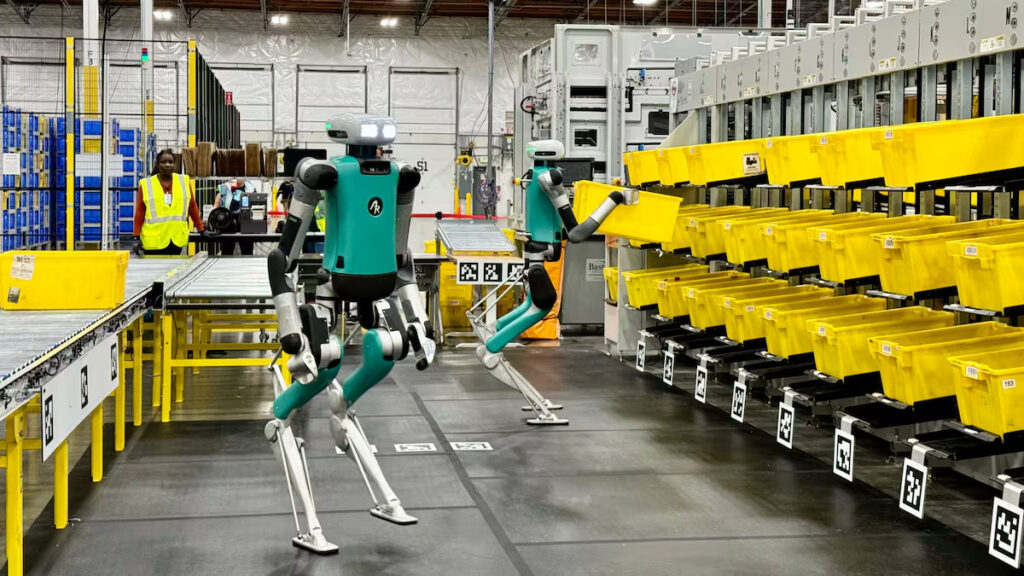In a move that is shaking the global job market, Amazon has rolled out new autonomous robots in the UK, signaling an accelerated push toward full warehouse automation. For years, Amazon was praised as a major job creator, offering warehouse roles to hundreds of thousands worldwide. But times are changing. The tech giant is now embracing robotics at an unprecedented scale, aiming to make robots outnumber human employees in its warehouses a milestone that raises both excitement and deep concern across industries.
While the efficiency gains are undeniable, the human cost of this automation wave cannot be ignored. Warehouse workers, unions, and labour experts are sounding the alarm: this is not just about innovation it’s about livelihoods, dignity, and the future of work.
A Glimpse Inside: Amazon’s Robotic Revolution
Amazon’s obsession with robotics is not new. Since 2020, the company has quietly deployed over one million robots, from sleek robotic arms to intelligent wheeled transporters that navigate warehouse floors with impressive precision. But now, the latest wave of autonomous robots in the UK marks a turning point.
These robots are smarter, faster, and capable of performing tasks that previously required human dexterity and decision making. According to Amazon UK spokesperson Emily Whitaker, “We are committed to building the safest, most efficient fulfilment network in the world. Our autonomous robots are essential to that vision.”
But behind the corporate optimism lies a more troubling reality.
Coventry Warehouse A Testbed for Full Automation
In Coventry, one of Amazon’s largest UK facilities, the future is already here. The warehouse has become a testbed for autonomous robots in the UK, where hundreds of machines glide through the aisles, lifting, sorting, and transporting goods without human intervention.
Workers report a significant decline in manual roles. “First, it was small tasks, like moving pallets,” says Ahmed Khan, a former warehouse associate. “But now, entire sections are run by robots. Friends I’ve worked with for years are being let go.”
The data supports his concerns. According to recent reports, Amazon UK has reduced human warehouse staff by nearly 15% in pilot locations where full automation is being tested.
Expert Opinions: Progress or Exploitation?
Industry experts remain divided. Dr. Sarah Ellison, a labour economist at Oxford University, believes this is an inevitable evolution. “Companies like Amazon are under immense pressure to optimize efficiency. Autonomous robots in the UK are simply the latest chapter in that story.”
However! trade union leaders and social scientists argue that the rapid pace of automation lacks safeguards for displaced workers. James O’Connor from the UK Workers’ Rights Alliance warns, “Without a clear plan for retraining and transition, we are looking at widespread economic displacement.”
Even within the tech community, some caution against blind optimism. Robotics engineer Dr. Priya Ramesh notes, “The technology is impressive, but we must ask: is automation serving society or sidelining it?”
The Human Impact of Automation
For many, the rollout of autonomous robots in the UK is not just a news headline it’s a personal crisis.
Karen Doyle, a 42 year old single mother from Birmingham, recently lost her job at an Amazon fulfilment centre. “I’ve worked there for six years. Suddenly, they told us the robots can do it faster, and our department was closed,” she shares. “I have bills, kids, and now, no income.”
Karen’s story is not unique. Thousands face similar situations as Amazon doubles down on its robotics strategy. And with no concrete government intervention, displaced workers are left scrambling for alternative employment.
Why Automation Is Inevitable but Risky
The case for automation, from a business perspective, is straightforward:
✅ Increased productivity
✅ Lower error rates
✅ No sick leaves or holidays
✅ Round the clock operations
But the societal risks are equally significant-
⚠️ Mass job losses in vulnerable communities
⚠️ Wage stagnation for remaining human workers
⚠️ Erosion of worker rights and bargaining power
⚠️ Mental health challenges linked to job insecurity
Economists warn that the displacement caused by autonomous robots in the UK may widen economic inequality unless proactive policies such as universal basic income, robust retraining programs, and stronger worker protections are implemented.
Can Humans and Robots Coexist?
Despite the grim outlook for many warehouse workers, some believe coexistence is possible. Amazon claims that automation creates new technical roles in robotics maintenance, software engineering, and system oversight.
But these roles require specialised skills, often beyond the reach of the average warehouse worker. Without substantial investment in education and reskilling, the gap between the displaced and the newly employed may only grow.
Governments, businesses, and communities must collaborate to ensure that the rise of autonomous robots in the UK does not come at the expense of human dignity.
A Future Rewritten by Automation
The introduction of autonomous robots in the UK by Amazon represents a seismic shift in the labour landscape. While it heralds a new era of efficiency and technological prowess, it also raises uncomfortable questions about job security, economic fairness, and what it means to be human in an increasingly automated world.
For now, the robots are here, and their numbers are only growing. The real challenge is ensuring that society adapts not just with awe for the machines, but with unwavering commitment to protecting people.

